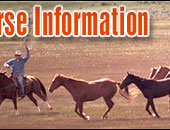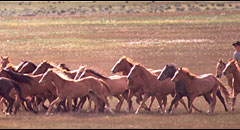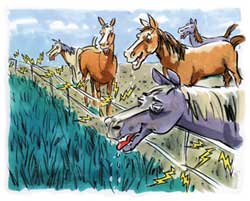 |
   |
|
|
|
You are here: Horses > Horse pasture / forage > Pasture prudence |
Managing Your Pasture – One Area at a Time
If you are one of the fortunate horse owners who have a lot of acreage when it
comes to pastures, you have probably quite frequently simply opened up the ban
door and let your horses out to graze at will wherever the fancy took them.
|
|
|
On the other hand, if you only have limited room to work
with, you know that doing so will result in a pasture that
is soon grazed down to the dirt. Thus it is not surprising
that owners of smaller pastures have found it useful to
manage their pasture by enforcing rotational grazing.
Frequently you might have noticed that a smaller pasture was
divided into sections, some of which were grazed down, some
of which looked like they were recuperating, and some of
which were still untouched. Divided by electric fence tape,
the horses are kept in the desired sections, while the
previously grazed on section is permitted to re-grow. The
rationale behind this policy is simple: the resting forage
will be able to channel its energy into growth and root
development and you will not have to face brown patches of
dirt. In addition to the foregoing, it has been shown that
rotational grazing also reduces the occurrence of weeds.
|
 Of
course, another aspect to proper pasture management is soil maintenance.
Obviously, it is not enough to just have healthy soil, but you will need to
monitor the soil to make sure that it has sufficient nutrients in it. Soil
testing will quickly reveal if your dirt has the essential nutrients that ensure
proper plant growth. By ways of a refresher course, what your soil needs to
contain to enable any growth are the major nutrients – potassium, phosphorus and
nitrogen – as well as the secondary nutrients – sulfur, calcium, and magnesium –
and of course the micronutrients – chlorine, boron, copper, zing, manganese,
iron, and molybdenum. Of
course, another aspect to proper pasture management is soil maintenance.
Obviously, it is not enough to just have healthy soil, but you will need to
monitor the soil to make sure that it has sufficient nutrients in it. Soil
testing will quickly reveal if your dirt has the essential nutrients that ensure
proper plant growth. By ways of a refresher course, what your soil needs to
contain to enable any growth are the major nutrients – potassium, phosphorus and
nitrogen – as well as the secondary nutrients – sulfur, calcium, and magnesium –
and of course the micronutrients – chlorine, boron, copper, zing, manganese,
iron, and molybdenum.
It is interesting to note that nitrogen in pastures that lack legumes is highly
limited, and supplementation of as much as 60 pounds per acre per grazing cycle
is required, as opposed to pastures with a mix of about 10 percent of legumes
which only require about 30 pounds of nitrogen. Your overall pH level should be
about 6 to 6.5. If you have acidic soil, ground limestone will help. Another
aspect of pasture maintenance actually has to do with the kinds of forage you
grow. Ideally, you should sow a mix that contains about 20 percent orchardgrass,
20 percent ryegrass, 10 percent timothy, five percent clover, and 45 percent
Kentucky bluegrass. Some horse owners substitute alfalfa for one of these
plants.
You will be able to do the most maintenance when your horses are not actually
grazing the entire pasture but instead are corralled so as to limit their
access. In winter this will prevent dormant plants from being eaten up or
trampled down, and you will be rewarded with healthy growth in the spring and
summer. When corralling the animals in summer, you will be able to allow grasses
grazed down to about three inches to rapidly re-grow to six inches, at which
point grazing may commence.
 |
Read the next horse pasture article on Feeding Horses Round Hay Bales. |
|
|
|
|
 |
|
|
|
|
|
Horse Education
|
|
|
|
|
Horse Information Topics
|
|
|
|
|
|
|
|
Horse Business Owners
|
| |
Advertise with Us
Have your horse products or services exposed to over 27,000 of our monthly visitors.
|
|
|
|
|
|